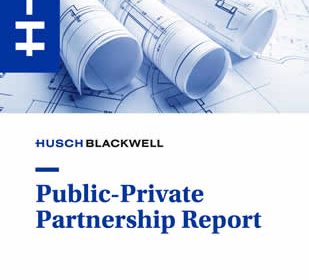Kansas City-based counsel Husch Blackwell found an expanding universe of building and non-building types, coupled with signs of greater public acceptance of creative project financing and delivery methods, in its fifth annual survey of Public-Private Partnership Conference & Expo participants.
During the early-March conference, Husch Blackwell queried city, county, state and education officials, along with participants from construction, consulting, design and engineering, financial advisory and lending institutions, on various factors relating to their evaluation and planned use of public-private partnerships (P3) to support future work. Respondents were asked to indicate their current level of involvement with such contracts, plus favorability of P3 projects and expectations for utilizing the method for future public facilities and infrastructure. Among key survey findings:
- 80 percent of private-side and 34 percent of public-side respondents are currently involved in a P3 project;
- 73 percent of public-side respondents said that a “current lack of understanding” regarding P3 is a strong or good reason for not doing a P3 project; only 48 percent of private-side respondents agreed;
- Notable declines from public and private respondents in their perceptions of public opposition to P3, as 42 percent of public respondents said public opposition was a strong or good reason for not doing a P3 project (versus 73 percent in 2018); 45 percent of private respondents said public opposition was a strong or good reason for not doing a P3 project, down from 64 percent in 2018; and,
- Government buildings and transportation once again earned the top spots from both public and private respondents as the most likely project types respondents will pursue over the next three years.
|
|
| The report is posted at www.huschblackwell.com. |
“The survey results generally do not change a great deal from year to year,” says Husch Blackwell P3 Practice Leaders Charles Renner, who compiled the Public-Private Partnership Trends Report. “So the marked decrease in the respondents’ perceptions toward public opposition to P3 is noteworthy. Particularly on the public side, I think decision-makers are gaining more confidence they can fashion agreements that work to the public’s benefit over the long term.”
The report analyzes many of the U.S. P3 projects that reached financial close since the beginning of 2017 and underscores some of the survey results, particularly concerning the ever-growing variety of project types and terms coming online in the past two years. Of note, authors observe, “P3s have evolved beyond their initial application on so-called horizontal infrastructure, such as highways and bridges, and into an array of vertical projects spanning everything from courthouses to prisons to university facilities.” Five of the 13 P3 contracts examined in the report concern vertical projects.
Expansion in the scope of P3 is powered in part by another trend noted in the report: Decline of the demand-risk concession model whereby private-side concessionaires bear the revenue risks associated with collecting fares, fees, and other revenues generated by infrastructure. Many newer P3 project types are not easily monetized and/or generate no revenue.
“We are definitely seeing a shift to availability payments as the preferred model in the U.S., even for traditional transportation projects,” notes Renner. “Governments are better equipped to deal with those long-term revenue risks; however, it really places great importance on properly balancing those risks within the agreement with appropriate private-side incentives and payments.”
